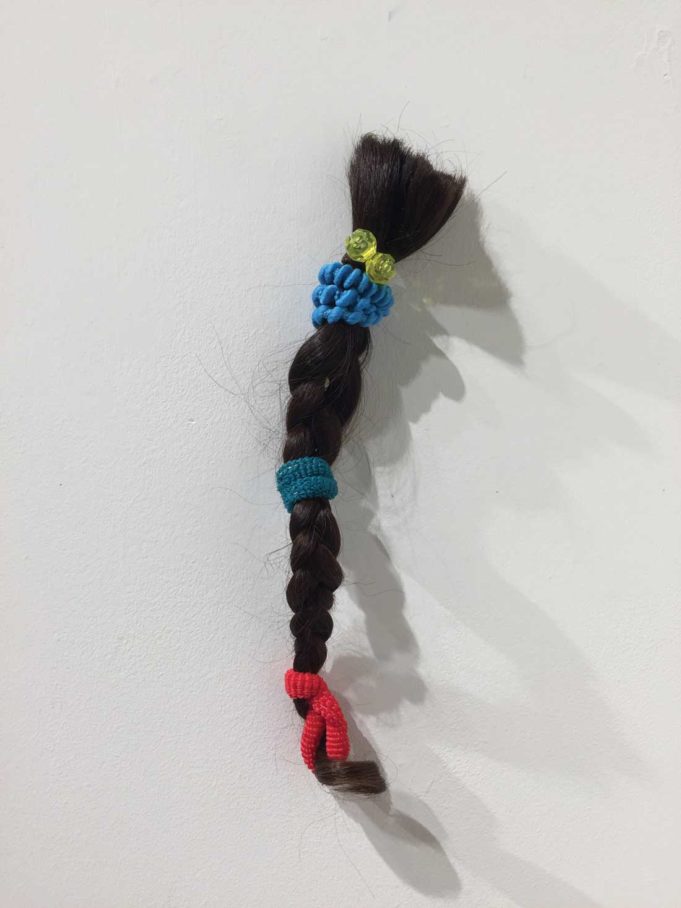In a city where artists can have a difficult time achieving professional advancement or become “career artists,” Fabiola Valenzuela may be upending that trend. Over the past year, her installations, which render themes of memory and identity through media as diverse as fabric, painting, video, and sheet cake have made their way to audiences at the Kimbell Art Museum and the Texas Biennial. Her work will also soon be featured at the upcoming Texas Vignette in Dallas and the Fusebox Festival in Austin.
For the first time since last April, Valenzuela’s work will be exhibited in Fort Worth as part of Out of Focus, a two-person show at Fort Works Art with Fort Worth painter Jesse Sierra Hernandez that aims to explore “a first-generation perspective of displacement.” I chatted with Valenzuela about her past year and her new body of work.
Weekly: The works in this show are more inwardly focused than pieces you’ve exhibited before. What prompted this turn?
Valenzuela: In previous works, I’d talk about my parents’ journey and [how] they got us to where we are. But I felt it was time to talk about my own perspective in what I’m going through. Not that I’m tired of talking about my parents, but rather what does that journey mean for me? The process of making these works has helped me to do that.
How would you describe that journey and your creative journey over the past year?
I was born in California, but I haven’t been there since I was 3. Texas does feel like home, but there are people in my family for whom Texas is not home. Investigating my culture, I am realizing I don’t know what I am. I can’t claim my indigenous side, and I can’t claim this European side. What does it mean to be an American? I don’t even know where I stand in that. I have to break this down to understand who I am. I’m trying to figure out where I belong.
You have played with femininity quite a bit in addressing cultural identity, such as in your previous use of embroidery and fabric. But in the installation “Dulce y Suave” at Fort Works, you seem to be focusing more on the nature of womanhood.
I am trying to dissect a lot of these labels that are placed on women of color [like] “brown sugar” or “piel canela.” There’s an expectation to be soft, sweet, or sexy. Even though my work comes off as soft and tender, I don’t feel that way.
I like to document process in my pieces, so while I was making these sugar bricks over four days [for “Dulce y Suave”], using my hands constantly to mix sugar and water together, I realized that my hands were being sandpapered. My hands, even my fingertips, were covered in cuts. I’m making this sweet, sultry installation, but I was getting worn and beat down. It spoke to me how we’re expected to accept this label as a compliment, but in reality we’re seen more as “an other’ed, exotic” than classically beautiful. It’s painful to be seen this way. These compliments are actually really cutting.
How do you see cultural beauty standards playing out in your circles or communities?
I see it when babies are born. “Did he come out guerito?” or “Did he come out prietito?” It’s ingrained in our culture to value those who have lighter skin. If I have darker skin, I am more likely to be seen as less than, even more so if I am a woman.
A lot of times art that deals with identity or that comes from an artist who hails from a marginalized community is seen to be political or critical of “whiteness.” But in your new work, you seem to be critical of attitudes within communities of color. Do you think your work should be seen as political? Are you concerned about being too adversarial toward your community?
I think it may be seen as political whether I like it or not. I think a lot of works by people of color are seen as political, even though they’re just talking about their life experience, because they are often seen as other.
As for my community – yeah, I am aware of that. And it’s scary. It’s a taboo subject. Most of us don’t feel that it’s an issue, or we feel like we’re being divisive [in pointing this out]. Two people can be Latin Americans, but because one of them has darker skin, they are seen as less than.
I love my people and culture. That’s why I want us to look more closely at how we perceive ourselves. I hope that by bringing this up, we can talk more openly about what this looks like. It’s scary to talk about, but I know it’s needed. We may want to ignore it because there are other things going on in the country. Latin Americans – Puerto Ricans, Dominicans, Nicaraguans, brown, white, black – we need to know ourselves and our community better.
You mentioned skin and colorism, and there are works in the show that speak to that like the wall murals “Está Prietito Pero Bonito” and the video “Untitled (No Me Digas Que Soy),” but where do you think your braid installations and studies fall into this discussion?
My little braid is my beginning me: my baby hair, my first and last curls. That’s a study of me, really. Just wearing braids in general as a kid has always carried a stereotype of looking real Mexican, like La India Maria, who is a popular and problematic character in Mexican film.
I named the long braid “Trenzuda,” and through that investigation of me braiding that hair, I wanted to think about how much more knowledge I can gain about my culture and myself. All this information – our overlapping identities, narratives about our culture and ourselves – are all woven together, and it’s kind of a knot we have to untangle ourselves.
Out of Focus
Thru May 5 at Fort Works Art, 2100 Montgomery St, FW. Free. 817-795-9475.












